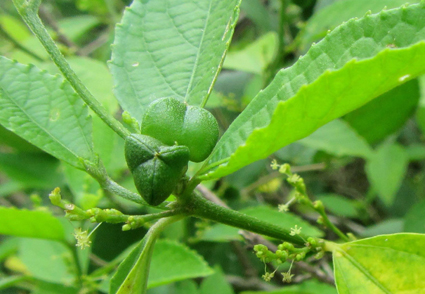Abstract
Bernardia fluviatilis is described as a new species of Euphorbiaceae from the Upper Paraguay River Basin in central South America. A literature review, examination of herbarium specimens, and fieldwork suggest that the new taxon is most similar to B. argentinensis but differs by its young branches covered by a sparsely sericeous indumentum of simple trichomes, usually shorter staminate peduncles, cymules scattered along the axis of the staminate inflorescence, and staminate flower pedicel usually glabrous. Illustrations, photographs, information about the distribution, habitat, and conservation status of the new species, and a key to the morphologically similar species, are also provided.
References
- Bachman, S., Moat, J., Hill, A.W., de la Torre, J. & Scott, B. (2011) Supporting Red List threat assessments with GeoCAT: geospatial conservation assessment tool. ZooKeys 150: 117−126. https://doi.org/10.3897/zookeys.150.2109
- Beentje, H.J. (2016) The Kew plant glossary: an illustrated dictionary of plant terms. Second Edition. Royal Botanic Gardens, Kew, 184 pp.
- Carrión, J.F., Cordeiro, I. & Amorim, A.M. (2019) A new Bernardia (Euphorbiaceae) with stellate trichomes from the Brazilian Cerrado. Systematic Botany 44: 826–831. https://doi.org/10.1600/036364419X15710776741431
- Carrión, J.F. (2020) Sistemática do Clado Bernardia. Thesis. Universidade Estadual de Feira de Santana, 356 pp.
- Carrión, J.F., dos Santos, F.A., Cordeiro, I. & Amorim, A.M. (2022) Bahiana, a new Euphorbiaceae (Acalyphoideae) genus from seasonally dry forest in northeastern Brazil, corroborated by molecular and morphological evidence. Taxon 71: 1196–1213. https://doi.org/10.1002/tax.12795
- Chodat, R. & Hassler, E. (1905) Plantae Hasslerianae soit enumeration des plantes recoltées au Paraguay par le Dr. Emile Hassler d’Aarau (Suisse), de 1885 à 1902. Bulletin de l’Herbier Boissier, ser. 2, 5: 288–506.
- Govaerts, R., Frodin, D.G., Radcliffe-Smith, A. & Carter, S. (2000) World checklist and bibliography of Euphorbiaceae (with Pandaceae). Royal Botanic Gardens, Kew, 1621 pp.
- IUCN (2022) Guidelines for Using the IUCN Red List Categories and Criteria. Version 15. Standards and Petitions Committee, 116 pp. Available from: https://www.iucnredlist.org/resources/redlistguidelines (accessed: 25 June 2023)
- Karsten, G.K.W.H. (1860) Florae Columbiae 1 (3). Ferdinand Duemmler Successores, Berlin, pp. 83–122.
- Lourteig, A. (1955) Euphorbiaceae argentinae. Addenda II. Arkiv för Botanik 3: 71–87.
- Miller, P. (1754) The Gardeners Dictionary. 4th abridged ed., 1. John and James Rivington, London, 524 pp.
- Müller Argoviensis, J. (1865) Euphorbiaceae. Vorläufige Mittheilungen aus dem für De Candolle’s Prodromus bestimmtem Manuscript über diese Familie. Linnaea 34: 1–224.
- Müller Argoviensis, J. (1874) Euphorbiaceae. In: Martius, C.F.P. von & Eichler, A.W. (Eds.) Flora Brasiliensis 11 (2). Friedrich Fleischer, Munich & Leipzig, 752 pp.
- Oliveira, L.S.D., Moro, M.F., Lughadha, E.M.N., Martins, F.R., Melo, A.L., Esser, H.-J. & Sales, M.F. (2013) Hidden in the dry woods: Mapping the collection history and distribution of Gymnanthes boticario, a well-collected but very recently described species restricted to the dry vegetation of South America. Phytotaxa 97: 1–16. https://doi.org/10.11646/phytotaxa.97.1.1
- Pax, F. & Hoffmann, K. (1914) Euphorbiaceae—Acalypheae—Mercurialinae. In: Engler, A. (Ed.) Das Pflanzenreich IV.147.VII (Heft 63). Wilhelm Engelmann, Leipzig, 474 pp.
- Pott, A., Oliveira, A.K., Damasceno-Junior, G.A. & Silva, J.S.V. (2011) Plant diversity of the Pantanal wetland. Brazilian Journal of Biology 71: 265–273. https://doi.org/10.1590/S1519-69842011000200005
- Radford, A.E., Dickison, W.C., Massey, J.R. & Bell, C.R. (1974) Vascular Plant Systematics. Harper & Row Publishers, New York, 891 pp.
- Thiers, B.M. (2023 [updated continuously]) Index Herbariorum. The New York Botanical Garden, New York. Available from: https://sweetgum.nybg.org/science/ih/ (accessed: 25 June 2023)


